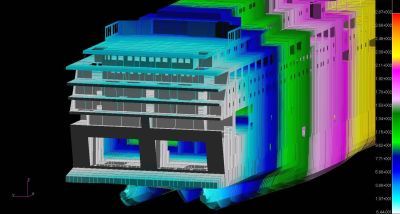
Denmark: Knud E. Hansen AS Executes Largest Ever Ship Lengthening Feasibility Study
Knud E. Hansen A/S has executed a feasibility study for the most extensive lengthening project in the history of ship conversions. Building a new 240m long vessel to transport cars and passengers (RO-PAX vessel) takes two years work on the shipyard and is a tremendous investment of about 120 million Euros.
Conversion, and more specifically lengthening, of a vessel can efficiently tackle the problem that some operators face with increased traffic demand. It is possible to do a lengthening within three months once the vessel is taken temporarily out of service for shipyard work. In this particular case, Knud E. Hansen A/S’s goal was to add an additional 65 meters (from 175m to 240m) to the length of an existing vessel. This can be done by cutting the vessel into two parts and including an additional 65 meters as its middle section.
In order to identify the most critical areas for this exceptional vessel lengthening and propose the required structural design solutions, a global finite element modeling (FEM) and analysis was carried out on the entire vessel. The lengthened model was investigated for the two operational loading conditions that produce the maximum hogging and sagging conditions as required by the Marine Classification Society. The most stressed areas of the vessel were then highlighted and shown by plot diagrams to identify the most crucial parts of the design.
MSC’s Patran and Nastran capabilities helped produce high quality results in a short timeframe.
The creation of the FEM model and the first global strength analysis of the vessel took about two months. The software also helped investigate the necessary modifications to reinforce the ship structure, for the design approval of the Marine Classification Society.
“MSC’s Patran and Nastran allowed easy creation of the FEM model by importing the geometry from the CAD model, and provided a quick analytical solution for such a complex task,” said Mirco Zoia, Naval Architect and Offshore Engineer at Knud E. Hansen A/S. “Thanks to the reliability of the software and to Knud E. Hansen A/S’s experience, the submission for approval of the calculation to the Classification Society has been quite straight forward and very successful.”
The study was submitted to the Marine Classification Society on behalf of a European ship owner, and was carried out using MSC’s Finite Element Analysis (FEA) software solutions.
Write Your Comments
We use cookies to improve your experience. By continuing to use our site, you accept our Cookies, Privacy Policy,Terms and Conditions. Close X

